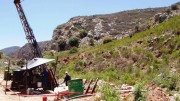Miners across the globe gritted their teeth in mid-November as commodity prices slumped further, continuing a decline that began more than a month ago.
Copper, the great bellwether of global economic health, saw its price drop 2.4% to 6.5-year lows on Nov. 16, the first trading day after the Nov. 13 terror attacks in Paris, as traders moved into relatively safer assets. Contracts for December delivery on the Comex settled at just US$2.12 per lb., off 2¢ from lows reached in May 2009.
Copper prices were already in decline before the attacks, having traded above US$2.40 per lb. as recently as early October. Copper prices were above US$2.90 per lb. six months ago and at US$3.08 one year ago. And those prices in early October were at the top of a mini-rally stoked by Glencore’s announcement of dramatic copper mine production cuts in Zambia and the Democratic Republic of the Congo, representing 5% of global mine output. In a larger time frame, copper prices have been on a steady march south since the February 2011 peak above US$4.50 per lb. that was the culmination of a sharp rise that had begun in January 2009, at the depths of the global recession.
Today, copper miners and traders are keenly trying to gauge the health of China’s slowing but commodity-hungry economy, which accounts for 45% of global copper demand. China’s economy grew by 6.9% year-on-year during the third quarter, making it the slowest quarterly expansion since the start of 2009. For all of 2015, Chinese economic growth is on track to be the slowest since 1990.
Christopher Kent, assistant governor of the Reserve Bank of Australia, told an audience at UBS’s Australasian conference in Sydney in mid-November that China’s transition from investment- to consumer-led growth is “happening gradually,” but that this trend away from raw commodity consumption suggests commodity prices have little room for recovery. He emphasized that “commodity prices remain relatively high. The bank’s index of commodity prices has fallen by about 50% from its peak, but is still almost 80% above early 2000 levels.” However, he added that the Reserve Bank believes commodity prices are unlikely to return to 2000 levels.
The same phenomenon is happening in the other industrial metals, most notably iron ore, which hit a four-month low of US$47 per tonne in mid-November on soft demand from China and continued oversupply from new mines, particularly in Australia. Iron ore prices are already down by a third this year as Aussie iron ore production and exports increase. As recently as mid-September, iron ore prices recovered to US$58 per tonne after crashing below US$45 per tonne in July.
Oil prices are also sagging back towards US$40 per barrel, reflecting both the sluggish global economy and the market-share war between the 13-nation Opec cartel and the upstart U.S. shale producers. At press time WTI crude stood at US$41.74 per barrel, while Brent crude traded at US$43.58 per barrel.
One reality of the shale-oil business is that production can decline relatively quickly from an individual well, and so many have anticipated sharp drops in U.S. oil production. This is indeed happening, but not as quickly as expected: U.S. oil production was 9.6 million barrels a day earlier this year and now stands at 9.1 million barrels, and could drop to 8.8 million per day next year, with 4 million barrels a day coming from shale.
The Opec countries — led by Saudi Arabia — have uncharacteristically kept their oil output at high levels during the price downturn, but it is unclear whether they can keep this strategy much longer, as many of the Opec countries are selling oil at a price below what is needed to maintain national budgetary surpluses.
Gold investors haven’t been any luckier, with prices depressed by a strong U.S. dollar, despite actual gold mine production declining from the all-time highs of recent years, and quarter after quarter of net buying of gold by the world’s central banks. Gold rose to US$1,084 per oz. in the first day of trading after the Paris terror attacks, but gave back all those gains a day later, and traded at a 5.5-year low of US$1,069 per oz. at press time — well below the US$1,179.60 30-day high recorded in late October.


Be the first to comment on "Editorial: Copper, iron, oil, gold prices all head south"